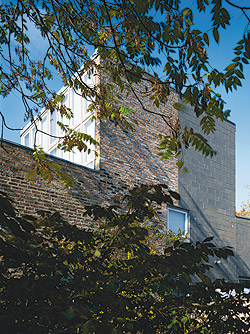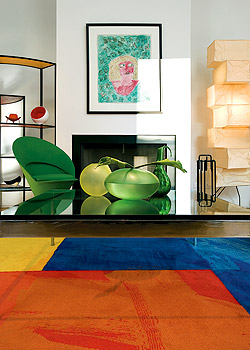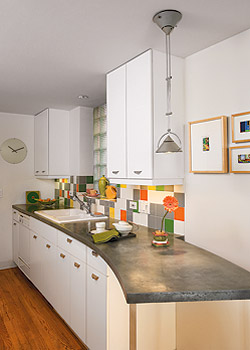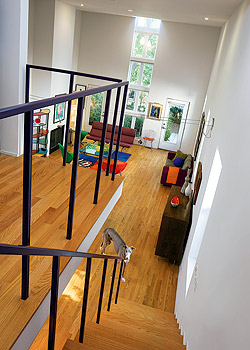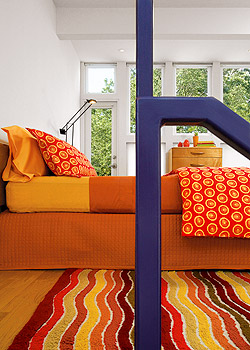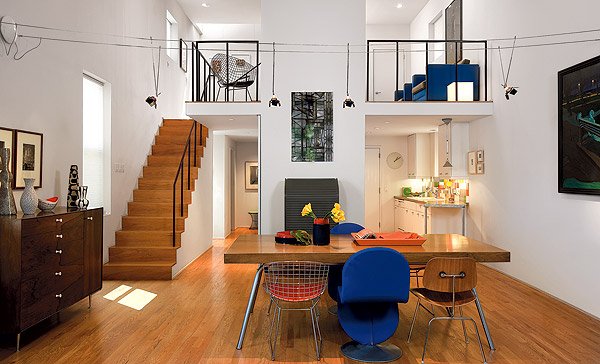
The architectural photographer Barbara Karant and I are sitting in the two-story living and dining area of her loftlike house in Bucktown one summer afternoon talking about how she came to be here. The rooms of others are her usual subjects; now her own place is the focus.
Dressed in her typical summer attire—denim shorts and a vibrant Hawaiian shirt—Karant, the principal of Karant+Associates, looks as if she is ready for a sophisticated urban luau. She fits right in here—in this lively, open space with white walls, warm light, and midcentury modern furniture covered in hot spots of bold color: cobalt blue, shamrock green, rose red. But a sense of peacefulness prevails; the presence of Karant’s three greyhounds—Fancy, Turtledove, and Slim—lulls us. Lithe, leggy beauties, each in a rhinestone-studded leather collar, they snooze soundly on their dog beds. Karant is the president of the Chicago-area rescue group Greyhounds Only, and her dogs are retired racers.
As an architectural photographer, Karant is a perfectionist, and her dogs seem like great kick-back, calm-down company for someone who is obsessed with her work. “They’re known as 40-mile-an-hour couch potatoes,” Karant says, explaining that many people have the mistaken idea that greyhounds are wound up and jumpy.
Karant herself was in total-motivation mode in 1995, when she decided that she wanted to sell her condomin-ium in the DePaul area (too many neighbors, not enough green space) and buy a house. Along the way, she asked Joe Valerio, a principal in the architecture firm of Valerio Dewalt Train Associates and a client since the early eighties, to check out possibilities. How could she go wrong? Obviously a fellow let’s-do-it kind of person, Valerio, when asked to provide a mission statement for an architectural directory, proffered this succinct phrase for his firm: “Build or die.” Karant and Valerio decided to build.
* * *
Photography: Barbara Karant; photo styling by Diane Ewing
|
|
Karant eventually bought an 1890s building in Bucktown—a single-story structure of Chicago common brick that at one time housed a grocery store; attached in back was a frame shanty. “I liked the neighborhood,” Karant says. “There were a lot of creative people, and it wasn’t as homogenous as Lincoln Park or DePaul.” It was quiet and close to the expressway, to downtown, and to Karant’s photography studio in the West Loop. “I live in a quadrant of Bucktown that doesn’t have a lot of activity,” she says, “but it’s only a ten-minute walk to go to a restaurant or a bar or shopping.”
Valerio was fascinated by the history of the property. “The house is neatly divided in half,” he explains. “The southern portion of Chicago common brick is one of the few remaining examples of 19th-century construction that predates the raising of all the city’s streets, which was crucial to draining the swamp that was Chicago. Steps adjacent to the sidewalk take you down to the original grade of this area of the city.” Owners were responsible for filling in the rest of their property, and initially many did not.
The frame building in back was not salvageable, Karant explains. “It took the contractor about 12 minutes to knock it down and cart it off the site,” Valerio says. To replace the shanty, they built a mirror image of the structure in front using black ground-face concrete block—the inexpensive modern-day equivalent of Chicago common brick. “The materials nicely connect the two centuries,” Valerio says, “and celebrate the revival of the neighborhood.”
Originally in front, the entrance to Karant’s house is now five steps down from the sidewalk along the side of the redesigned structure, where the brick and the concrete block meet. And whenever Karant walks in, she is pleased with what she sees. “Joe did a great job of giving me a wonderful house within the confines of what I could afford,” Karant says. “I got the wood floors; I got the fireplace. It’s a simple house, but it looks really good, and I like the quality of the light.”
* * *
Photography: Barbara Karant; photo styling by Diane Ewing
|
|
A portrait by Lee Godie of a blonde with Cleopatra-like hair hangs above the fireplace. Karant has a number of works by outsider artists, and over the years, she has traded photographs of her own for paintings, prints, and photos by colleagues. “I love everything here,” she says, “so it won’t ever leave.” She is a committed collector, as well, of Blenko glass, Italian ceramics, and Fiesta dinnerware.
Karant bought most of the furniture in her living and dining areas at auction at Wright. Among her prizes are a compact sofa by Charles and Ray Eames with the original Alexander Girard upholstery, an orange slice chair by Pierre Paulin, and a rosewood-veneer cabinet by George Nelson. She found the cone chair and ottoman by Vernor Panton at Modern Times. Beneath a glass-and-steel coffee table is a Per Arnoldi rug from Luminaire in blocks of brilliant color.
The loveseat across from the fireplace, now covered in purple with gray cushions, previously belonged to the Mid-America Club, a client of Kar- ant’s. Displayed above are a large painting with figures both Greek and contemporary by the Chicago artist Bill Herman, a portrait by Sybil Gibson of another contemplative blonde, and a photograph by Karant from 1984—one of a series of rooms that she constructed in her studio. The painterly scene features a room with a comfortable chair, a standing lamp, and a TV; it is a domestic space that seems personal and mysterious—a peek into a private sanctuary.
* * *
Photography: Barbara Karant; photo styling by Diane Ewing
|
|
Valerio addressed the interior of Karant’s house with the same confident logic that he brought to restoring and rebuilding the exterior. Clarity, balance, and easy access were the point. On the first floor, a tower of glass at the north end, framed by two glass-fronted doors, centers attention on the backyard—a fenced-in greyhound romp-around destination shaded by a tall silver maple. One of Karant’s favorite paintings—a complex electric-blue still life by Aaron Bohrod—hangs beside the door on the right. Karant’s mother, an actress and drama teacher, bought the painting in the seventies.
The kitchen is tucked in at the south end of the first floor, and the tile above the counters—in orange, apple green, gray, white, and yellow—presented a challenge for Karant. “It’s supposed to be a random design,” she says, “but because I’m fairly obsessive about things, I couldn’t just have the contractor randomly put the tile up.” He delivered the tile on a Friday and gave her until Monday to decide how to arrange it. “Then I proceeded to drive myself crazy for the balance of the weekend,” Karant recalls, “getting the perfect look of randomness with no apparent pattern to the color.”
Valerio calls this side of the house the tower of functions—it comprises the kitch- en and service areas on the first floor; the study and workroom, open to the living room, on the second floor; and the bedroom and master bath on the third floor, with views to the north and the south. “The intention,” Valerio says, “is to create a great interior space punctuated by movement up the staircase, which wraps around the tower.”
* * *
Photography: Barbara Karant; photo styling by Diane Ewing
|
|
Later in the afternoon, beside the tower, at Karant’s walnut dining table by Ralph Rapson, we look at material for two books she has in progress. The first will feature photos of greyhounds, which Karant has been taking since 1999, soon after she got Slim. “Everything about them is aerodynamic, and they’re sexy dogs,” Karant says. They are so long and curvaceous that in the photos they often seem to be more of an aesthetically refined abstraction than real. “And they’re sweet,” Karant adds. “They’re demonstrative but not in a pushy way.”
The working title for the second book, a collaboration between Karant and the writer Yvonne Zipter, is Greyhound: The Evolution of a Breed. In what Karant calls her unspare time, she and her business partner, Laura Dion-Jones, develop products for their Web site Snob Hounds, which sells collars, leashes, and apparel (a percentage goes to rescue groups). “Snob Hounds is like Nike meets Donna Karan,” Karant says. “It’s functional layered clothing for the dogs.” But one jazzy number came from elsewhere.
Among the greyhound photos, I find a shot of Slim dressed for a Halloween gathering in a Hawaiian shirt much like one of Karant’s own. He has a lei around his neck. He looks festive and ready to roll.
* * *
Photography: Barbara Karant; photo styling by Diane Ewing
RESOURCES
|
|
Andrew Hollingsworth, 222 West Huron Street; 312-440-9554. The Anne Kyrro Quinn orange throw in the living room, the tall orange bottle vase in the bedroom.
Arrelle Fine Linens, 445 North Wells Street; 312-321-3696. Schlossberg mandarin-orange pillowcases and bottom sheet.
Design Within Reach, dwr.com. The Sapien bookshelf, the Knoll orange seat cushions for the Harry Bertoia chairs.
Elements, 102 East Oak Street until mid-October, then 741 North Wells Street; 312-642-6574. The Anichini green napkin and the colored resin bangles around the flowers in the kitchen; the Lappas orange leather tray and the Anichini orange napkins and placemats on the dining-room table; the small and medium orange porcelain vases by Ted Muehling for Nymphenburg in the bedroom; the orange Murano drinking glass and the Christiane Perrechon soap dish in the bathroom.
Diane Ewing, 652 West Grand Avenue, 312-560-4430; dianeewing.com. The photo stylist.
Gallery Bernard, 2902 North Lincoln Avenue, 773-248-9363. The Heywood-Wakefield bedroom set.
Greyhounds Only, 335 East Geneva Road #173, Carol Stream; 847-421-9828 or 773-297-4739, greyhoundsonly.com. A greyhound rescue group.
Herman Miller, 321 Merchandise Mart; 312-822-0140. The molded plywood chairs by Charles and Ray Eames.
Homer Laughlin China Company, 672 Fiesta Drive, Newell, West Virginia; 800-452-4462. Vintage Fiesta dinnerware.
Karant+Associates (Barbara Karant, principal), 400 North May Street; 312-733-0891, karant.com. The photographer.
Knoll, 1111 Merchandise Mart; 312-454-6920. The Knoll orange seat cushions for the Bertoia chairs.
Lane Custom Framing Ltd., 400 North May Street; 773-412-2454. Picture framing.
Lightology, 215 West Chicago Avenue; 312-944-1000. The Tech Lighting K-Johnny Kable Lite fixture with barn-door shades in the dining area and the Tizio table lamp by Richard Sapper in the bedroom.
Luminaire, 301 West Superior Street; 312-664-9582. The Modus Vivendi square gray porcelain plate and the Gemini porcelain with metal accent teapot, cup, and saucer in the kitchen; the Anna Torfs raven red Barragan Coupe vase and bowl on the dining-room table; the furniture miniatures from the Vitra Design Museum, the Ivan Baj Air D glass vase in pea green, the Anna Torfs Vaza IV glass vase in sanded lime, and the Per Arnoldi rug in the living room.
Macy’s, selected stores. Signoria Firenze rust quilt used as tailored bed skirt and rust top sheet.
Material Possessions, 704 North Wabash Avenue; 312-280-4885. The Lappas leather tissue box and the lemon soap in the bathroom.
Modern Times, 2100 West Grand Avenue; 312-243-5706, moderntimeschicago.com. The Vernor Panton cone chair and ottoman.
Printworks Gallery, 311 West Superior Street, Suite 105; 312-664-9407. The paintings by Nicholas Sistler.
Snob Hounds, 312-933-7325, snobhounds.com. Dog clothing and accessories.
Soupcan, 1500 South Western Avenue; 312-243-6928, soupcan.com. The zinc countertops in the kitchen.
Steelskin, 1500 South Western Avenue; 312-738-1544. The bathroom medicine cabinet.
Valerio Dewalt Train Associates (Joe Valerio, principal), 500 North Dearborn Street, Suite 900; 312-332-0363, buildordie.com. The architect.
Wright, 1440 West Hubbard Street; 312-563-0020, wright20.com. The George Nelson cabinet, the Pierre Paulin chair, the Vernor Panton dining chairs, and other modernist pieces.
Photography: Barbara Karant; photo styling by Diane Ewing




